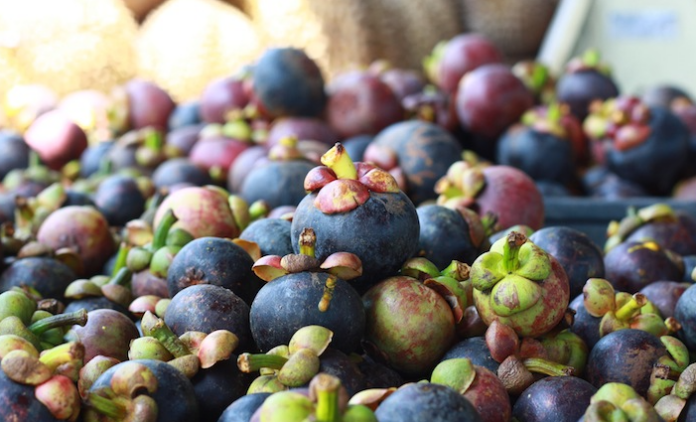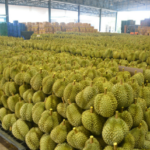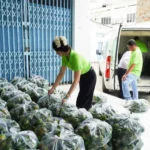
Illustrative Image
According to reports from Thai media outlets, the prices of durian and mangosteen in Thailand are experiencing a significant drop. Durian currently costs around 70–80 Thai baht (approximately 2.15–2.45 USD per kg), while mangosteen prices have plummeted to a ten-year low, ranging between 12 and 14 baht (about 0.37–0.43 USD per kg).
The lower quality of the early-season durian from Southern Thailand has led Chinese importers to halt purchases, pushing prices below 100 baht (3.07 USD per kg). Meanwhile, the sharp decline in mangosteen prices is mainly attributed to this year’s bountiful harvest, with many fruit growers opting to sell their produce directly without sorting by quality.
The durian season in Eastern Thailand is expected to end by late June. This year, fewer exporters and packing houses have resulted in an early halt to durian purchases. Unstable weather conditions and heavy rainfall have contributed to lower-quality durian, prompting traders to shift their focus to the south, where the durian season is just beginning.
In contrast, a large supply of durian from neighboring countries and a reduced number of exporters have made prices more volatile. In Eastern Thailand, the farm gate prices of durian grades A and B have dropped to 70–85 baht per kg, while prices offered by packing houses stand at 90–95 baht per kg.
In previous years, end-of-season prices for grades A and B durian from packing houses ranged from 145 to 150 baht per kg. This price decline has also affected the early-season durian from Southern Thailand, which initially commanded prices of 180–200 baht per kg.
The owner of a large packing house in Chanthaburi province revealed that selling durian from Eastern Thailand has been challenging this year due to issues such as the presence of yellow oxide and excessive cadmium levels, as well as the recent influx of low-quality durian in the market. Some durian appears ripe but has hard flesh, poor taste, and low sugar content. Others get damaged during transportation, making them unfit for export to China and forcing sellers to sell at a loss. Many packing houses have incurred significant financial losses, with each container resulting in losses of up to 2–3 million baht (61,300–92,000 USD).
At roadside markets across Chanthaburi and Trat provinces, mangosteen prices have dropped sharply by 3–5 baht per kg within just two days. On June 15, premium mangosteen was sold at 17–18 baht per kg, while mixed grades were at 14–15 baht per kg. By June 16, prices had decreased further, with premium mangosteen costing 12–15 baht per kg and mixed grades at 10–13 baht per kg.
Mangosteen growers are appealing to the government for help in stabilizing prices, suggesting that premium mangosteen should ideally be priced at 40–50 baht per kg. Packing houses have reported significant inventory backlogs and challenges in sorting and packing mangosteen promptly. In response, some farmers are considering a coordinated harvest suspension for three or four days to push prices higher. However, the abundant supply of affordable lychees in the Chinese market poses challenges, making it difficult to sell mangosteen at higher prices.
The mangosteen yield in Eastern Thailand is currently high, with daily harvests reaching 300–400 tons, compared to around 200 tons per day during the same period last year. However, according to Duenrung Benjamas, President of the Thai Mangosteen Association, the lack of packing facilities and inadequate logistics systems have led to a steep decline in mangosteen prices, further exacerbated by the low durian prices.
As of now, about 70% of the mangosteen crop has been harvested, while some orchards are just beginning their season. Mangosteen prices peaked at the start of the season (May) at 110–120 baht per kg (3.37–3.68 USD), but by the end of May, they had dropped to 50–60 baht per kg (1.53–1.84 USD) and hit a record low of 12–14 baht per kg (0.37–0.43 USD) in mid-June. Despite the season extending into July, the current prices are unprecedentedly low.
Industry experts attribute the annual decline in mangosteen prices to a recurring issue, but the situation is particularly severe this year in Eastern Thailand. This is believed to be due to authorities’ failure to utilize production data for timely response planning, resulting in a reactive approach when supply exceeds demand.
The Magic of 2 a.m. in Bac Giang: A Decade of Unprecedented Scenes.
In the lush province of Luc Ngan in Bac Giang, Vietnam, farmers tend to their lush lychee orchards with diligent care. Each day begins early, with a pre-dawn start at 2 am, as they carefully hand-pick the delicate fruit to meet the day’s first shipments. Such dedication ensures that the prized Luc Ngan lychees are delivered fresh and sweet to markets near and far. For these farmers, it’s a labor of love that continues to bear fruitful rewards.
The King of Fruits: A Tale of Unfortunate Circumstances for Durian Farmers
Once hailed as “green gold”, durian has been a game-changer for many rural communities. However, with changing weather patterns and a lack of technical advancement, the volatile nature of the market has become apparent.
The Great Fruit Price Plunge: A Grim Outlook for Growers
The Mekong Delta region is in the midst of its peak harvest season for an abundance of tropical fruits. However, amidst the specialty of durian, which has seen a billion-dollar industry take a hit with falling prices, many other fruits are facing a similar fate. A bountiful supply coupled with sluggish consumer demand has resulted in a price plunge for various fruits, leaving farmers struggling to find buyers.











































